
The Caetrati were a type of light infantry in ancient Iberia who often fought as skirmishers. They were armed with a caetra shield, swords, and javelins. [1] [2] [3]

The Caetrati were a type of light infantry in ancient Iberia who often fought as skirmishers. They were armed with a caetra shield, swords, and javelins. [1] [2] [3]
Iberian warriors had been fighting as mercenaries throughout Europe since the 5th century BC, with their ferocity in battle and their fighting skills making them very good additions to any ancient army. The Carthaginian general Hannibal made excellent use of them during his campaigns against Rome during the Second Punic War; when the Romans defeated Carthage and conquered its colonies in Hispania, they soon began to expand their borders in the region; it took them 200 years to fully conquer and pacify the region. These warriors fought vigorously against the Romans, especially under the leadership of Viriathus the Lusitanian and his guerrilla tactics that the Romans had never seen before. Being agile by nature, and wearing almost no armour at all, these warriors were extremely mobile and would use hit-and-run tactics to harass the enemy and break their formations.

The majority of these soldiers wore simple tunics and lacked real armour because they relied on greater mobility. The cardiophylax was a very common piece of protection in ancient Iberia, most likely circular and with decorations and reliefs depicting animals and patterns. Strabo states the Celtiberians used a linen cuirass, probably in the Greek style. On the other hand, a number of vase paintings clearly show Iberian infantrymen wearing cuirasses of mail armour, with leather straps hanging down to protect the abdomen, but these heavier types of armour were probably used by the scutarii instead. The Iberians do not seem to have worn greaves, but Strabo states the Celtiberians did, and a number of reliefs do show infantrymen wearing greaves and short boots. The greaves may have been of metal or leather, but the ordinary soldier would probably have had greaves of felt.
The Iberians wore bronze helmets, sometimes of Greek and Corinthian shape (due to Greek influence and trade in the southern and eastern parts of the peninsula), with either a low or high crest, but they seem to have been rare. They were probably worn only by the nobles and the tribal leaders. The crests are said to have been purple or crimson. The most common headwear seems to have been a simple helmet of bronze or leather, occasionally extended at the back to form a neckguard and with cheek guards added at the sides. Strabo says the Lusitanians wore helmets of sinew with a crest, and sculptures in southern Spain and South-west France do show some form of crested cap or hood. Diodorus Siculus says the Celtiberians wore helmets of brass or copper with red plumes. Another helmet widely used was the Montefortino helmet.
These helmets were mass-produced and used during the First and Second Punic Wars, the Celtiberian Wars, the Lusitanian Wars and in the Civil War between Caesar and Pompey. Montefortino helmets were believed to have originated in the Celtic occupied lands of northern Italy and soon became very common throughout the entire western Mediterranean. This helmet was so well thought of, and at the time so advanced, that it has been supposed that the Romans rapidly adopted it into their army. The Lusitanians seem to have not worn face guards perhaps because they blocked peripheral vision or just got in the way during combat. The soldiers would place a mane of dyed horse hair of various colours in it, or coloured feathers, perhaps to identify which tribe or military unit he belonged to or to signify rank, like a Roman centurion worn to indicate status within the Roman military formation.
This was the only shield these light infantrymen used, hence their name. The shield was circular, with a diameter between 30 cm and 90 cm. It was tied to the warrior's body with ropes or leather strips that passed over the shoulder and that gave great mobility to fight both on foot and on horseback. The shapes and decorations of the shields had variations in their metal, wood or leather protection. In combat, the shield was not only effective at blocking, but also an extremely proficient secondary weapon: Iberian troops used the boss to punch opponents. These compact bucklers could be hung on a belt or across the back by a strap, so as not to be burdensome to the soldier on the march or foraging for food, but still handy for when the enemy was close. Cavalry would usually carry the buckler so as to not over encumber their mounts or limit their horsemanship.

Of all the weapons the Caetrati bore, the sword is the one that stands out the most. Iberians, Celtiberians and Lusitanians were among the finest swordsman of their time.
The most emblematic weapon used by these warriors. It was without a doubt their weapon of choice for over several centuries. This can be said due to the large amounts of these swords found on excavation sites throughout Portugal and Spain.
According to the classical texts, the falcata used in the Iberian Peninsula was manufactured to perfection. Lusitanian warriors maintained a spiritual connection to their swords and when they died their swords were buried with them. Diodorus reports that the falcatas were of such superior quality that no helmet, shield or bone could resist its devastating effect.
References to the gladius hispaniensis are abundant in classical texts. During the Roman conquest of the Iberian Peninsula, the Romans experienced firsthand the effectiveness of this sword. In the beginning of the Roman presence on the peninsula during the Second Punic War, Roman legions came into contact with Iberian mercenaries, impressed with the technical and operational levels of their swords, they quickly adopted and began using Iberian swords.
Warriors from Iberia made extensive use of spears. The spear was used by all iberian tribes and was described by many different terms, indicating a vast variety of models. They would throw the javelins in volleys to disorganize the enemy formation before charging into close combat with swords. These warriors used the javelin with deadly accuracy. From modern archaeological research, there seems to have been an assortment of spears which have been classified into three groups: traditional and conventional spears of wooden shafts and metal heads, the all-iron type called soliferrum by the Romans, and Lances.
Of all the conventional spears and javelins the Iberian people used, the falarica was the most dreaded. Livy makes a reference to it when mentioning that the falarica was used by the iberians against the Carthaginians near Saguntum. The falarica was a javelin with a long iron pointed rod of about 90 cm (35 inches) in length with a short wooden handle. Although the iron spearhead was a thin rod, a section was thick, giving the weapon weight to further improve its ability to penetrate and making it an armour-piercing weapon. Several vase paintings show the use of javelin thongs, wound round the shaft to impart a stabilizing spin and additional thrust when it was thrown. This weapon was so feared that when it stuck into a shield without entering the body, it terrified the enemy. As well as being a throwing spear, it was also used as a ranged incendiary device: bundles of grass or packs filled with a combustible substance were bound to it and ignited. During sieges, the burning falarica was thrown against wooden palisades and thatched roofs to start fires and cause havoc. When the Iberians were besieged, they hurled flaming falaricas at the besiegers’ siege engines. As an incendiary device, it had an enormous psychological effect, helping to spread fear among enemy troops.

The soliferrum was an Iberian ranged pole weapon made entirely of iron. It was forged from a single piece of iron usually measuring between 1.5 and 2 meters in length and around 1 cm in diameter. Though slim, the central part was usually thickened to facilitate a hand's grip. Sometimes there were mouldings of about 10 cm wide in the middle of the weapon to further improve grip and to prevent it from slipping because of sweaty hands. The soliferrum was an extremely effective heavy javelin. The weight and the density of its iron shaft, its small diameter and its narrow tip made the soliferrum an excellent armour-piercing weapon when it was thrown at close range, enabling it to further penetrate heavy shields and armour. Unlike the falarica, the soliferrum remained in use in the Iberian Peninsula under Roman rule until the end of the third century AD.
In the collection at the Archaeological Museum of Zaragoza there is another type of throwing weapon which is rarely found, known as a tragula. The tip of this barbed spear came in several different forms. Usually it had only a sharpened tip with two or more small protruding spikes. This hybrid spear was something of a dart or arrow which was thrown from a long leather thong by which it was then recovered if possible. It proved to be dangerous to its user and deadly to its victim, for the barbed dart required to be cut out of its victim. Some minted Roman-Iberian coins bore on their reverse sides a military motif of a rider armed with a tragula.

Hoplites were citizen-soldiers of Ancient Greek city-states who were primarily armed with spears and shields. Hoplite soldiers used the phalanx formation to be effective in war with fewer soldiers. The formation discouraged the soldiers from acting alone, for this would compromise the formation and minimize its strengths. The hoplites were primarily represented by free citizens – propertied farmers and artisans – who were able to afford a linen or bronze armour suit and weapons. It also appears in the stories of Homer, but it is thought that its use began in earnest around the 7th century BC, when weapons became cheap during the Iron Age and ordinary citizens were able to provide their own weapons. Most hoplites were not professional soldiers and often lacked sufficient military training. Some states maintained a small elite professional unit, known as the epilektoi or logades since they were picked from the regular citizen infantry. These existed at times in Athens, Sparta, Argos, Thebes, and Syracuse, among other places. Hoplite soldiers made up the bulk of ancient Greek armies.

Infantry is a specialization of military personnel who engage in warfare combat. Infantry generally consists of light infantry, irregular infantry, heavy infantry, mountain infantry, motorized infantry, mechanized infantry, airborne infantry, air assault infantry, and naval infantry. Other types of infantry, such as line infantry and mounted infantry, were once commonplace but fell out of favor in the 1800s with the invention of more accurate and powerful weapons.

A shield is a piece of personal armour held in the hand, which may or may not be strapped to the wrist or forearm. Shields are used to intercept specific attacks, whether from close-ranged weaponry or projectiles such as arrows, by means of active blocks, as well as to provide passive protection by closing one or more lines of engagement during combat.
The pilum was a javelin commonly used by the Roman army in ancient times. It was generally about 2 m long overall, consisting of an iron shank about 7 mm (0.28 in) in diameter and 600 mm (24 in) long with a pyramidal head, attached to a wooden shaft by either a socket or a flat tang.

A peltast was a type of light infantry originating in Thrace and Paeonia and named after the kind of shield he carried. Thucydides mentions the Thracian peltasts, while Xenophon in the Anabasis distinguishes the Thracian and Greek peltast troops.
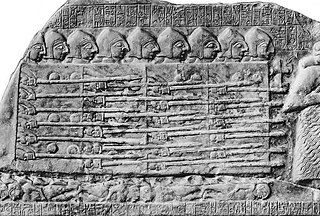
The phalanx was a rectangular mass military formation, usually composed entirely of heavy infantry armed with spears, pikes, sarissas, or similar polearms tightly packed together. The term is particularly used to describe the use of this formation in ancient Greek warfare, although the ancient Greek writers used it to also describe any massed infantry formation, regardless of its equipment. Arrian uses the term in his Array against the Alans when he refers to his legions. In Greek texts, the phalanx may be deployed for battle, on the march, or even camped, thus describing the mass of infantry or cavalry that would deploy in line during battle. They marched forward as one entity.

The falx was a weapon with a curved blade that was sharp on the inside edge used by the Thracians and Dacians. The name was later applied to a siege hook used by the Romans.
The falcata is a type of sword typical of pre-Roman Iberia. The falcata was used to great effect for warfare in the ancient Iberian Peninsula, and is firmly associated with the southern Iberian tribes, among other ancient peoples of Hispania. It was highly prized by the ancient general Hannibal, who equipped Carthaginian troops with it during the Second Punic War.
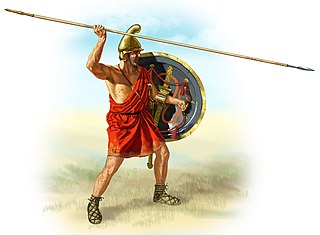
The Kingdom of Macedon possessed one of the greatest armies in the ancient world. It is reputed for the speed and efficiency with which it emerged from Greece to conquer large swathes of territory stretching from Egypt in the west to India in the east. Initially of little account in the Greek world, it was widely regarded as a second-rate power before being made formidable by Philip II, whose son and successor Alexander the Great conquered the Achaemenid Empire in just over a decade's time.
Soliferrum or Soliferreum was the Roman name for an ancient Iberian ranged polearm made entirely of iron. The soliferrum was a heavy hand-thrown javelin, designed to be thrown to a distance of up to 30 meters. In the Iberian language it was known as Saunion.
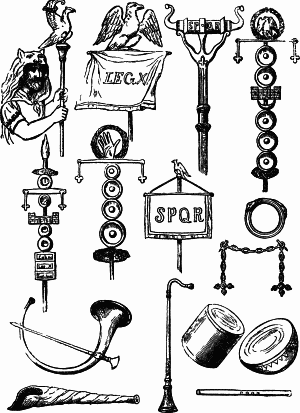
Roman military personal equipment was produced in large numbers to established patterns, and used in an established manner. These standard patterns and uses were called the res militaris or disciplina. Its regular practice during the Roman Republic and Roman Empire led to military excellence and victory. The equipment gave the Romans a very distinct advantage over their barbarian enemies, especially so in the case of armour. This does not mean that every Roman soldier had better equipment than the richer men among his opponents. Roman equipment was not of a better quality than that used by the majority of Rome's adversaries. Other historians and writers have stated that the Roman army's need for large quantities of "mass produced" equipment after the so-called "Marian Reforms" and subsequent civil wars led to a decline in the quality of Roman equipment compared to the earlier Republican era:
The production of these kinds of helmets of Italic tradition decreased in quality because of the demands of equipping huge armies, especially during civil wars...The bad quality of these helmets is recorded by the sources describing how sometimes they were covered by wicker protections, like those of Pompeius' soldiers during the siege of Dyrrachium in 48 BC, which were seriously damaged by the missiles of Caesar's slingers and archers.
It would appear that armour quality suffered at times when mass production methods were being used to meet the increased demand which was very high the reduced size cuirasses would also have been quicker and cheaper to produce, which may have been a deciding factor at times of financial crisis, or where large bodies of men were required to be mobilized at short notice, possibly reflected in the poor-quality, mass produced iron helmets of Imperial Italic type C, as found, for example, in the River Po at Cremona, associated with the Civil Wars of AD 69 AD; Russell Robinson, 1975, 67
Up until then, the quality of helmets had been fairly consistent and the bowls well decorated and finished. However, after the Marian Reforms, with their resultant influx of the poorest citizens into the army, there must inevitably have been a massive demand for cheaper equipment, a situation which can only have been exacerbated by the Civil Wars...

A javelin is a light spear designed primarily to be thrown, historically as a ranged weapon. Today, the javelin is predominantly used for sporting purposes such as the javelin throw. The javelin is nearly always thrown by hand, unlike the sling, bow, and crossbow, which launch projectiles with the aid of a hand-held mechanism. However, devices do exist to assist the javelin thrower in achieving greater distances, such as spear-throwers or the amentum.

Ancient Celtic warfare refers to the historical methods of warfare employed by various Celtic people and tribes from Classical antiquity through the Migration period.
Falarica, also Phalarica, was an ancient Iberian ranged polearm that was sometimes used as an incendiary weapon.
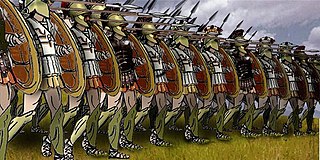
Heavy infantry consisted of heavily armed and armoured infantrymen who were trained to mount frontal assaults and/or anchor the defensive center of a battle line. This differentiated them from light infantry who were relatively mobile and lightly armoured skirmisher troops intended for screening, scouting, and other tactical roles unsuited to soldiers carrying heavier loads. Heavy infantry typically made use of dense battlefield formations, such as shield wall or phalanx, multiplying their effective weight of arms with force concentration.

Illyrian weaponry played an important role in the makeup of Illyrian armies and in conflicts involving the Illyrians. Of all the ancients sources the most important and abundant writings are those of Ennius, a Roman poet of Messapian origin. Weapons of all sorts were also placed intact in the graves of Illyrian warriors and provide a detailed picture for archaeologists on the distribution and development of Illyrian weaponry.

The hippika gymnasia were ritual tournaments performed by the cavalry of the Roman Empire to both practice their skills and display their expertise. They took place on a parade ground situated outside a fort and involved the cavalry practicing manoeuvring and the handling of weapons such as javelins and spears. The riders and their mounts wore highly elaborate armour and helmets specially made for display purposes, decorated with images from classical mythology. Such tournaments served several purposes, improving the riders' skills, helping to build unit morale and impressing dignitaries and conquered peoples.
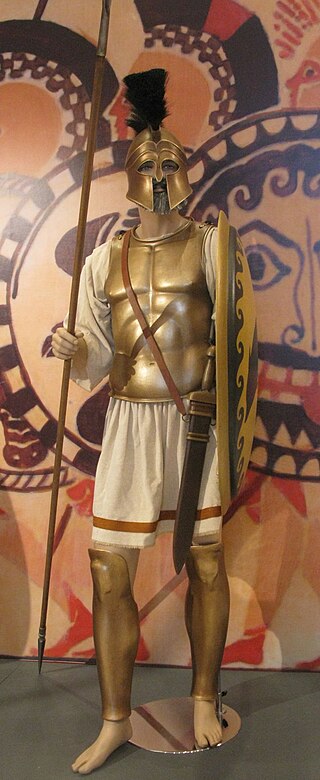
Ancient Greek weapons and armor were primarily geared towards combat between individuals. Their primary technique was called the phalanx, a formation consisting of massed shield wall, which required heavy frontal armor and medium-ranged weapons such as spears. Soldiers were required to provide their own panoply, which could prove expensive, however the lack of any official peace-keeping force meant that most Greek citizens carried weapons as a matter of course for self-defence. Because individuals provided their own equipment, there was considerable diversity in arms and armor among the Hellenistic troops.
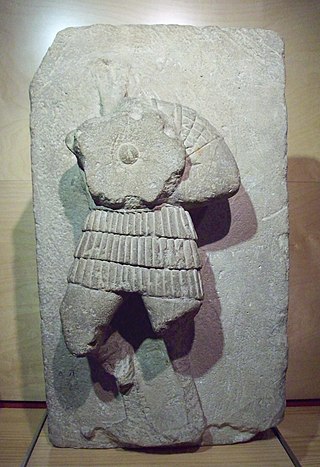
Caetra was the shield used by Iberian, Celtiberian, Gallaecian and Lusitanian warriors. The shield was circular shaped with a diameter between 30 cm to 90 cm. It was tied to the warrior's body with ropes or leather strips that passed over the shoulder and that gave great mobility to fight both on foot and on horseback. The shapes and decorations of the shields had variations in their metal, wood or leather protection. Warriors that carried this shield were usually light infantry called caetratus.

Warfare in ancient Iberian Peninsula occupied an important place in historical chronicles, first during the Carthaginian invasion of Hispania, including the Punic Wars, and later during the Roman conquest of the peninsula. The densely bellicose character of the Pre-Roman peoples who inhabited Hispania was repeatedly shown in their conflicts against Rome, Carthage and each other.
He sent out Octavius Graecinus with a strong force of ten cohorts armed as legionaries – we do not know whether these troops were Spanish or Roman or a mixture of both – and ten cohorts of Spanish light infantry caetrati, supported by 2,000 cavalry commanded by Tarquitius Priscus. They moved by night, avoiding detection by Pompey's main force, and took up a position along the route which they knew the convoy would have to take on its return journey. These officers amply ...
Light infantry used the caetra, a light, round, and slightly convex buckler shield of Spanish design made of leather, wicker, or wood with a metal boss and handgrip. The caetrati infantry was armed with javelins and the falcata sword, and its troops relied upon speed and agility in sword-and-buckler combat. Hannibal often used his light troops more adventurously than his enemies did theirs. Along with slingers, the caetrati carried out all the classic tasks of light infantry including ...
Both were light-armed troops, such as might be used to guard an encamped army or intended to hold a position on the wing of a battle-line. ... Rather, as L. xliv 40.4—6 says, the bodies of light-armed troops were stationed as outposts on either side.46 That is what emerges too from the account of Zonaras ix 23: 'at first these troops (those near the watering-point) fought by themselves, and ... 1, caetrati (so-called from their shield resembling a Spanish shield), and also for the troops who ...